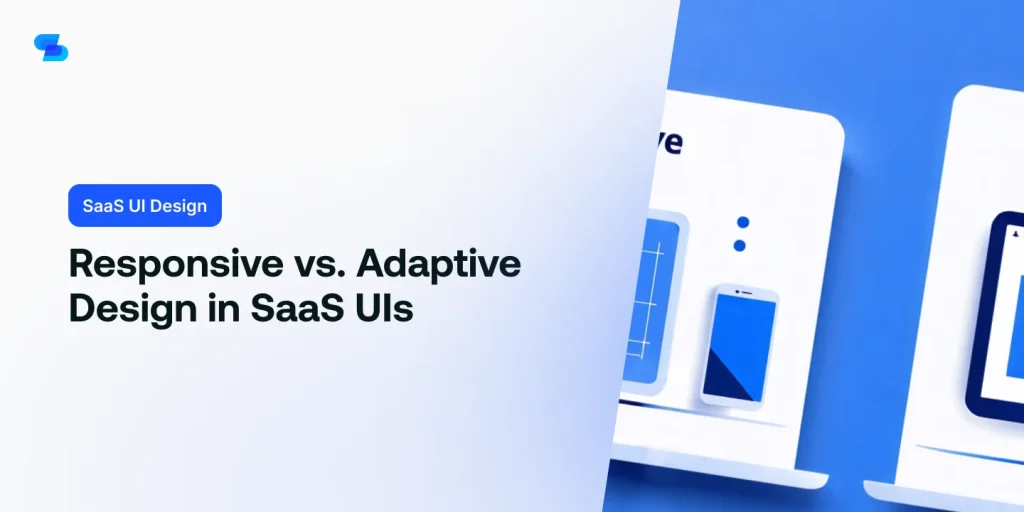When designing a SaaS UI, you’re faced with a critical decision: responsive or adaptive design? Both approaches have their strengths, but which one will best serve your users? Responsive design guarantees a seamless experience across various screen sizes, while adaptive design customizes the layout based on device specifications. You’ll need to take into account user behavior, performance, and the level of customization required to drive engagement. By weighing these factors, you’ll be able to create an interface that truly resonates with your users. But which approach will you choose, and what are the implications of your decision?
1. Understanding Responsive Design Principles
As you explore the world of responsive design, you’ll find that its core principle is to craft a user interface that seamlessly adapts to various screen sizes and devices, guaranteeing an ideal user experience regardless of how users access your SaaS application.
This means creating a design that’s highly flexible and able to adjust to different screen resolutions, orientations, and devices. You’ll need to prioritize mobile usability, as more and more users are accessing your application on-the-go.
A responsive design guarantees that your UI looks and functions great on smaller screens, with intuitive navigation and easy-to-tap elements. To achieve this, focus on design flexibility, using techniques like fluid grids, flexible images, and media queries to create a layout that scales effortlessly.
By doing so, you’ll be able to provide a consistent and engaging experience across different devices, ultimately driving user satisfaction and loyalty.
2. Key Characteristics of Adaptive Design
You’ll identify adaptive design by its ability to detect the user’s device, screen size, and browser type, and then serve a customized layout and visual design tailored to those specific characteristics.
This approach prioritizes user-centered design, guaranteeing an ideal experience for each individual user.
Adaptive design involves creating multiple versions of a design, each refined for a specific set of devices or screen sizes. This allows for precise control over the layout, visuals, and functionality, resulting in a highly customized and responsive user interface.
When implementing adaptive design, scalability considerations are essential. You must consider how the design will adapt to different devices and screen sizes while maintaining a consistent user experience.
By doing so, you’ll make certain that your SaaS UI is both functional and aesthetically pleasing, regardless of the device or browser used to access it.
3. Designing for Multiple Screen Sizes
When designing for multiple screen sizes, you’ll need to take into account the varying dimensions and resolutions of devices, from smartphones to desktop monitors, to guarantee your SaaS UI adapts seamlessly and provides a superior user experience regardless of the screen real estate.
To ascertain mobile usability, prioritize touch interactions and simplify navigation. Consider the thumb-friendly zones on mobile devices and allocate interactive elements accordingly. This will improve the overall user experience and reduce friction. For instance, you can use larger tap targets, clear typography, and intuitive iconography to facilitate effortless navigation.
Additionally, consider the different screen orientations and aspect ratios. Ascertain that your design adapts to landscape and portrait modes, and that critical elements remain accessible and visible.
4. The Role of Media Queries
Media queries become your greatest ally in crafting responsive designs, allowing you to define breakpoints that trigger specific styles based on device screen sizes, orientations, and even device types. By leveraging media query techniques, you can create a seamless user experience across various devices and platforms.
When it comes to responsive breakpoints, you’ll want to identify the most critical screen sizes for your SaaS UI. This might include common desktop, tablet, and mobile screen sizes, as well as specific orientations like landscape or portrait mode. By defining these breakpoints, you can tailor your design to respond accordingly, ensuring that your UI adapts to each device’s unique characteristics.
To get the most out of media queries, you’ll want to use them in conjunction with other responsive design techniques. For instance, you might use media queries to adjust font sizes, padding, and margins at specific breakpoints, while also incorporating flexible grids and images to create a truly responsive design.
5. Flexible Grids in Responsive Design
Your flexible grid system serves as the backbone of your responsive design, providing a robust structure that adapts seamlessly to various screen sizes and devices.
By using fluid layouts and grid systems, you can guarantee that your design elements scale and adjust accordingly, without compromising the overall user experience. This means that whether your users access your SaaS UI on a desktop, tablet, or mobile device, your layout will adapt to fit their screen size.
To create an effective flexible grid, you’ll need to define a set of rules that govern how your layout will behave at different breakpoints. This involves setting up a grid system that uses relative units, such as percentages or ems, instead of fixed units like pixels.
By doing so, you’ll be able to create a responsive design that’s both flexible and adaptable. Remember, the key to a successful flexible grid is to keep it simple, flexible, and modular.
6. Adaptive Design Breakpoint Strategy
When developing an adaptive design breakpoint strategy, you’ll need to decide on an approach that works best for your SaaS UI.
You can opt for a device-agnostic breakpoint system, which focuses on the user’s behavior rather than the device itself, or a screen size-based approach that’s more traditional.
Alternatively, you can prioritize your content and create a framework that adapts to the user’s needs.
Device-Agnostic Breakpoint System
You can create a device-agnostic breakpoint system by defining breakpoints based on specific screen sizes or content requirements, rather than targeting specific devices or orientations. This approach guarantees that your design adapts seamlessly to various devices and screen sizes.
To implement this system, establish a breakpoint hierarchy that categorizes screens into distinct groups based on their dimensions or content needs. For instance, you might have breakpoints for small, medium, and large screens, each with its own set of layout rules.
Using fluid layouts, you can define the layout characteristics for each breakpoint, guaranteeing that your design elements scale and adjust accordingly. By doing so, you’ll create a responsive design that’s not tied to specific devices or orientations.
This flexibility is particularly important in SaaS UI design, where users may access your application from a wide range of devices. By defining breakpoints based on screen sizes or content requirements, you’ll guarantee that your design is optimized for every user, regardless of how they access your application.
Screen Size-Based Approach
Five common screen sizes – extra small, small, medium, large, and extra large – serve as the foundation for a screen size-based approach, allowing designers to create tailored layouts for each size range.
By designing for specific screen sizes, you can guarantee that your SaaS UI is refined for mobile devices, which is essential for user accessibility. This approach involves creating multiple layouts, each tailored to a specific screen size range, to provide a superior user experience.
When implementing a screen size-based approach, you’ll need to evaluate factors like content hierarchy, typography, and imagery. You’ll want to prioritize content that’s most important for each screen size, making certain that users can easily access the information they need.
Mobile optimization is key, so be sure to test your design on various mobile devices to confirm a seamless user experience. By doing so, you’ll be able to create a UI that’s both visually appealing and functional, regardless of the device or screen size.
Content Priority Framework
By structuring your content into a priority framework, you can systematically determine which elements to emphasize or hide at each adaptive design breakpoint, guaranteeing a seamless user experience across various devices and screen sizes.
This framework helps you organize your content into a clear hierarchy, allowing you to prioritize essential information and features that align with user intent.
At each breakpoint, you can then decide what to display, hide, or modify based on the content’s importance and the user’s goals.
For instance, on smaller screens, you might prioritize calls-to-action, key metrics, or critical information, while secondary content can be hidden or condensed.
7. Performance Comparison of Both Approaches
When it comes to performance, responsive design tends to be more resource-intensive, as it requires the browser to render multiple layouts and adapt to different screen sizes on the fly. This approach can lead to slower page loads, higher bounce rates, and a negative impact on your SaaS UI’s overall performance metrics.
On the other hand, adaptive design is more lightweight, as it only loads the necessary layout and assets for a specific screen size. This approach results in faster page loads, lower bounce rates, and improved performance metrics.
As you enhance your SaaS UI’s performance, it’s crucial to evaluate user behavior. You need to understand how users interact with your application on different devices and screen sizes.
8. Impact on User Experience and Engagement
Your SaaS UI’s user experience and engagement hinge on a delicate balance between responsiveness and adaptiveness, as a seamless, device-agnostic interface can make all the difference in capturing users’ attention and driving conversions.
A responsive design that adapts to different screen sizes and devices can greatly improve user retention, as users can easily access your SaaS application on their preferred device. However, it’s vital to guarantee design consistency across devices to maintain a cohesive user experience.
Conducting usability testing and gathering user feedback can help you identify areas for improvement and optimize your design for better engagement metrics. A mobile-first approach can also help you prioritize the most important features and create a clear visual hierarchy.
Furthermore, considering user demographics and guaranteeing feature accessibility can further enhance the overall user experience. By focusing on interaction design and adaptiveness, you can create an interface that’s both intuitive and responsive, leading to increased user satisfaction and ultimately, driving business growth.
9. Choosing the Right Design Approach
Two fundamental approaches to designing a SaaS UI – responsive and adaptive design – require careful evaluation, as selecting the right one can make a significant difference in the overall user experience and, ultimately, your business’s bottom line.
When choosing between responsive and adaptive design, you need to reflect on your design philosophy, user needs, and development cost. Think about the maintenance challenges you might face with each approach and the scalability options they offer. Your project timelines will also be impacted by your design choice, so it’s crucial to take these factors into account upfront.
Once you’ve made your decision, gather user feedback to validate your design approach. Confirm your design meets industry standards and test your UI using various testing strategies to measure performance metrics.
10. Future of SaaS UI Design Trends
As you’ve nailed down your design approach, you’re likely wondering what’s on the horizon for SaaS UI design, and how you can future-proof your product to stay ahead of the competition.
Well, here’s a sneak peek: minimalist interfaces are taking center stage. Users are craving simplicity, and designers are responding with clean, uncluttered designs that prioritize functionality over flashy visuals. This trend is all about stripping away the noise and getting back to basics.
Another trend that’s gaining traction is dark mode. It’s not just about aesthetics; dark mode can improve readability, reduce eye strain, and even conserve battery life. As more users demand seamless, intuitive experiences, you’ll need to stay ahead of the curve by incorporating these design elements into your product.
To Wrap Up
Now that you’ve weighed the pros and cons of responsive and adaptive design, it’s time to put your newfound knowledge into action.
Remember, responsive design excels in simplicity and fluidity, while adaptive design provides tailored experiences.
Consider your users’ needs, performance constraints, and desired customization level when choosing the right approach.
By doing so, you’ll create a seamless, engaging UI that drives user satisfaction and sets your SaaS apart from the competition.

